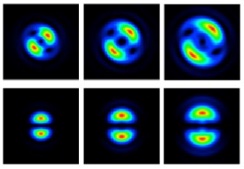 Our new paper in Optics Express entitled Gouy phase effects on propagation of pure and hybrid vector beams reports a theoretical simplified model and experimental analysis of the Gouy phase effects on vector beams. Experimental results at various axial planes, before and past the focus, are obtained by using a simplified liquid-crystal spatial light modulator-based optical system that allows the easy generation of these beams. Furthermore, a new alternative optical set-up that is devoid of moving elements is demonstrated, which simplifies this study.
Our new paper in Optics Express entitled Gouy phase effects on propagation of pure and hybrid vector beams reports a theoretical simplified model and experimental analysis of the Gouy phase effects on vector beams. Experimental results at various axial planes, before and past the focus, are obtained by using a simplified liquid-crystal spatial light modulator-based optical system that allows the easy generation of these beams. Furthermore, a new alternative optical set-up that is devoid of moving elements is demonstrated, which simplifies this study.
We experimentally verify the differences between pure and hybrid vector beams upon propagation. While the first ones remain stable, hybrid vector beams show Gouy phase effects that demonstrate an optical activity where the local polarization states rotate by an angle that depends on the propagation distance.
This study has been conducted in collaboration with our friends at San Diego State University, Prof. Jeffrey A. Davis and Prof. Don M. Cottrell.
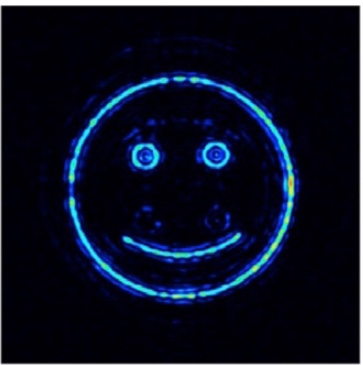 A new paper of ours is published in the journal Optical Engineering entitled Holographic projection system with programmable control of state of polarization, focus plane, and size of the reconstruction
A new paper of ours is published in the journal Optical Engineering entitled Holographic projection system with programmable control of state of polarization, focus plane, and size of the reconstruction
This work presents a holographic projection system based on the encoding of computer-generated holograms onto a spatial light modulator. We show how the size, location, and polarization state of the output can be controlled completely electronically, without physically moving any element in the system. And we show that the system is capable to produce optical logical operations by superimposing two different images encoded onto orthogonal polarization states.
The work has been done with our friends at the Department of Physics at San Diego State University.
jueves, 27 de diciembre de 2018
i.moreno
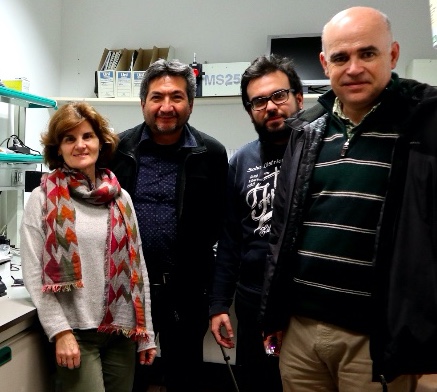 During the last two weeks we had the pleasure of receiving our friend Asticio Vargas, from Departamento de Ciencias Físicas, Universidad de La Frontera, Temuco, Chile.
During the last two weeks we had the pleasure of receiving our friend Asticio Vargas, from Departamento de Ciencias Físicas, Universidad de La Frontera, Temuco, Chile.
We have been advancing in new experiments and new projects. The fruitful UMH-UFRO collaboration continues in good shape.
viernes, 21 de diciembre de 2018
i.moreno
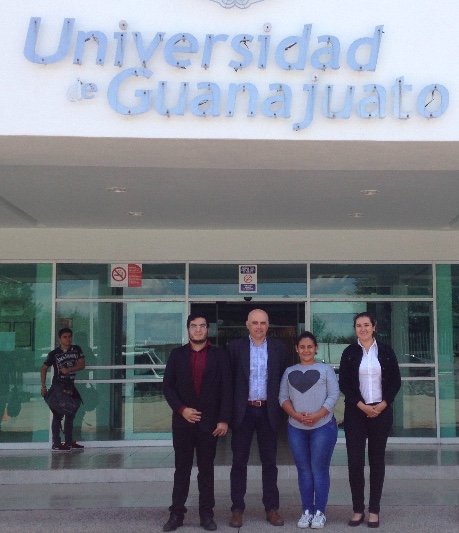 Ignacio Moreno visited the University of Guanajuato, in Salamanca, Mexico, invited with the OSA Travelling Lecturer Program by the OSA Student Chapter.
Ignacio Moreno visited the University of Guanajuato, in Salamanca, Mexico, invited with the OSA Travelling Lecturer Program by the OSA Student Chapter.
In August 30th, 2018, he delivered a lecture about Digital Holography with Spatial Light Modulators.
In this talk, he introduced the principles of SLMs and some of their applications when displaying phase-only holograms to engineering students of University of Guanajuato.

sábado, 1 de septiembre de 2018
i.moreno
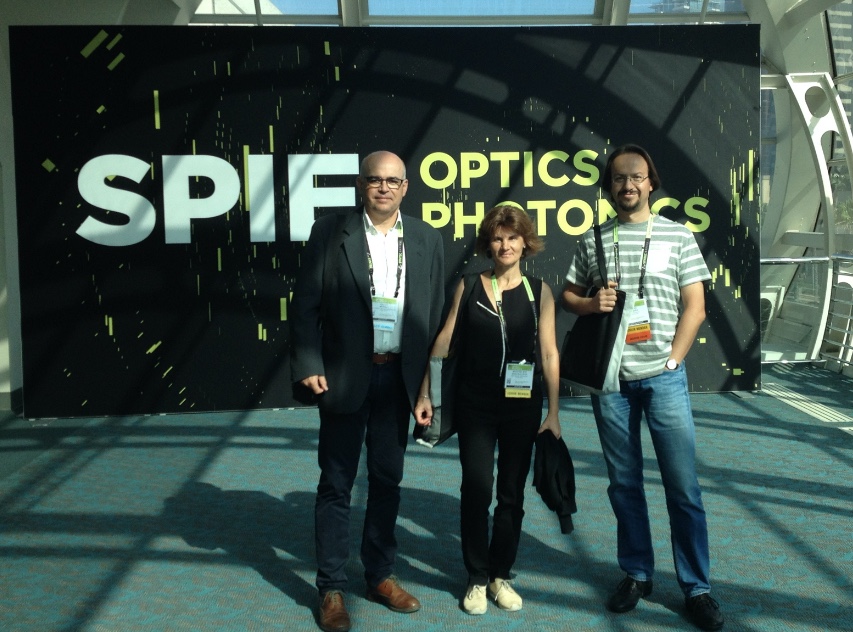 María M. Sánchez-López and Ignacio Moreno attended the meeting SPIE Optics and Photonics 2018, held in San Diego (USA) in August from 19th to 23th.
María M. Sánchez-López and Ignacio Moreno attended the meeting SPIE Optics and Photonics 2018, held in San Diego (USA) in August from 19th to 23th.
Maria participated in the conference «Laser Beam Shaping XVIII» where she presented the talk entitled Extending the use of commercial Q-plates for the generation of high-order and hybrid vector beams.
Ignacio participated in the conference «Optics Education and Outreach V», where he delivered the invited talk The first International Day of Light in Spain.
Click on the titles to go the corresponding papers and presentations.
The picture shows us with our friend Andres Márquez, from Universidad de Alicante.
miércoles, 15 de agosto de 2018
i.moreno
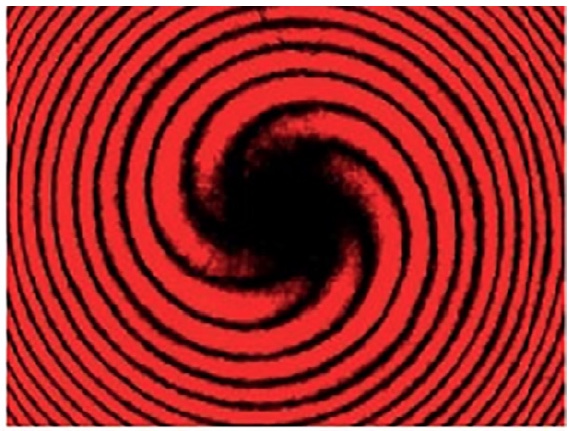 We published a new paper in Optics & Lasers in Engineering entitled Geometrical-phase lens based optical system for the spin-splitting of vector beams.
We published a new paper in Optics & Lasers in Engineering entitled Geometrical-phase lens based optical system for the spin-splitting of vector beams.
In this work we combine a geometric phase lens and a telescope system to produce an optical system with two polarization controlled real foci with equal magnification. And we apply it to characterize vortex beams and vector beams, splitting longitudinally the circular polarization components and focusing them into different axial planes.
This work was develop din collaboration with our friends Asticio Vargas and Fabián Torres-Ruiz, from Universidad de La Frontera, Temuco (Chile). And it is part of the PhD Thesis of Aarón Cofré.
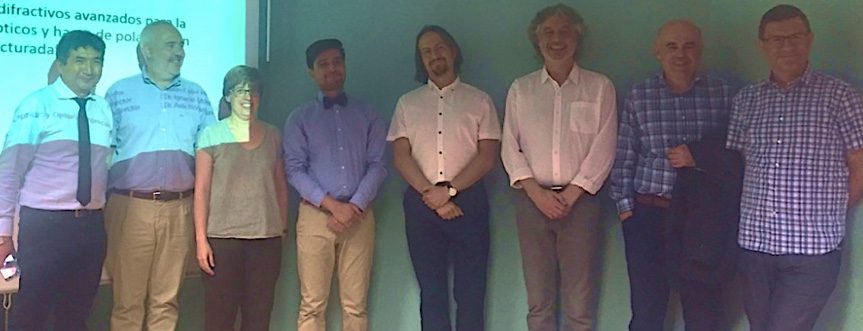 On July 10th 2018, Aarón Cofré presented the defense of his PhD Thesis entitled Development of advanced diffractive systems for the generation of optical vortices and structured polarized beams.
On July 10th 2018, Aarón Cofré presented the defense of his PhD Thesis entitled Development of advanced diffractive systems for the generation of optical vortices and structured polarized beams.
The Thesis has been supervised by Ignacio Moreno and Asticio Vargas, and included various experimental studies on how to generate optical vortices and vector beams.
The results of the thesis resulted in four articles published in the journals European Journal of Physics, Optics & Lasers Technology, Optics Express and Optics & Lasers in Engineering respectively.
In the picture, Aarón with the supervisors and the members of the jury.
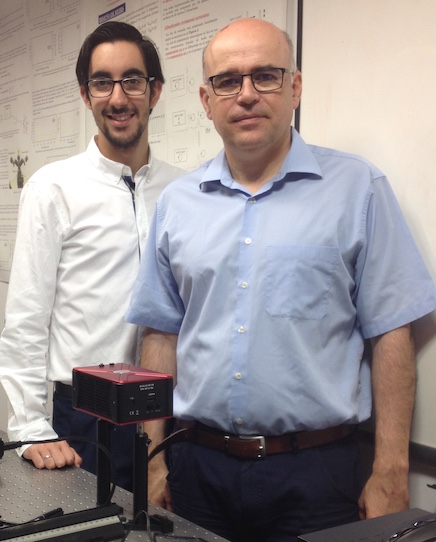 On July 9th, 2018, Santiago López, student of the Grade of Telecommunications Engineering, defended his final degree project entitled Caracterización de moduladores de cristal líquido para la generación de hologramas de fase y su optimización.
On July 9th, 2018, Santiago López, student of the Grade of Telecommunications Engineering, defended his final degree project entitled Caracterización de moduladores de cristal líquido para la generación de hologramas de fase y su optimización.
In this work, Santiago developed a characterization of the phase properties of some new displays acquired at the TecnOPTO Lab, and developed new methods and designs to generate phase-only holograms with them.
The project, supervised by Ignacio Moreno, received the maximum qualification
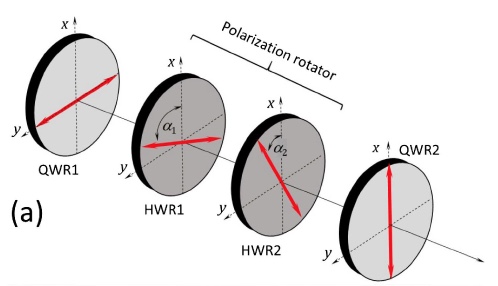
We published a new paper in Optics Letters entitled Achromatic linear retarder with tunable retardance.
In this work we present a universal design and proof-of-concept of a tunable linear retarder of uniform wavelength response in a broad spectral range. It consists of two half-wave retarders (HWR) between two quarter-wave retarders (QWRs), where the uniform retardance can be tuned continuously by simply rotating one of the HWRs. A proof-of-concept of this design is built by using commercially available Fresnel rhomb retarders that provide retardation with almost wavelength uniformity in the visible and near infrared from 450 to 1550 nm. The system is experimentally demonstrated to control the state of polarization of a super-continuum laser.
The work has been developed in collaboration with Asticio Vargas, from Universidad de la Frontera, Chile. And it is part of the PhD thesis of Abdelghafour Messaadi.
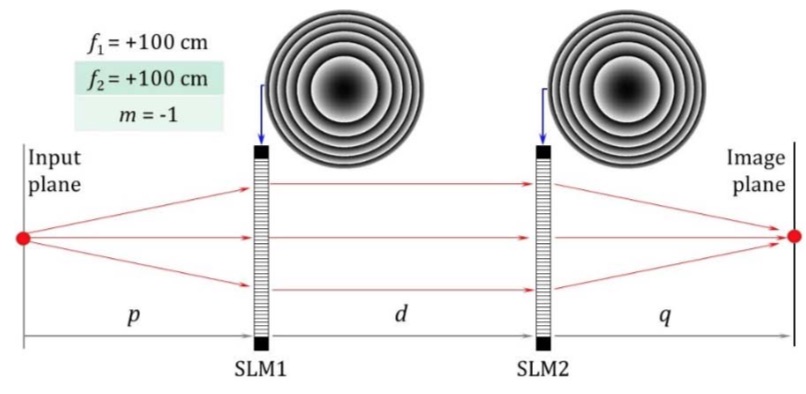 A new paper has been published entitled Programmable zoom lens system with two spatial light modulators: Limits imposed by the spatial resolution, published in the journal Applied Sciences, in a special issue devoted to liquid crystal on silicon devices.
A new paper has been published entitled Programmable zoom lens system with two spatial light modulators: Limits imposed by the spatial resolution, published in the journal Applied Sciences, in a special issue devoted to liquid crystal on silicon devices.
This paper deals with the realization go a zoom lens system that used two liquid-crystal SLMs, so different magnifications can be obtained without any moving elements, simply by changing the focal length of the lenses displayed in each SLM. We include results with positive and negative magnifications. And we analyze the limits imposed by the limited spatial resolution of the SLMs.
The work has been developed at the Department of Physics at San Diego State University, with the participation of Ignacio Moreno.
 Our new paper in Optics Express entitled Gouy phase effects on propagation of pure and hybrid vector beams reports a theoretical simplified model and experimental analysis of the Gouy phase effects on vector beams. Experimental results at various axial planes, before and past the focus, are obtained by using a simplified liquid-crystal spatial light modulator-based optical system that allows the easy generation of these beams. Furthermore, a new alternative optical set-up that is devoid of moving elements is demonstrated, which simplifies this study.
Our new paper in Optics Express entitled Gouy phase effects on propagation of pure and hybrid vector beams reports a theoretical simplified model and experimental analysis of the Gouy phase effects on vector beams. Experimental results at various axial planes, before and past the focus, are obtained by using a simplified liquid-crystal spatial light modulator-based optical system that allows the easy generation of these beams. Furthermore, a new alternative optical set-up that is devoid of moving elements is demonstrated, which simplifies this study.









